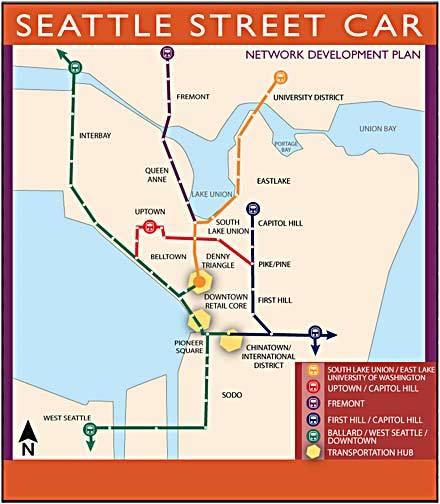City council eyes streetcar network
<b>Map courtesy of the Seattle Department of Transportation</b>
Mon, 01/28/2008
City Council members are considering leveraging the success of the South Lake Union Streetcar to build trolleys across the city, including a line that would link West Seattle, downtown and Ballard.
Chair of the council's transportation committee Jan Drago said since initial ridership for the South Lake Union car has been promising, there's drive to build a citywide system.
"I am very pleased with all the energy and ideas that the streetcar network has generated," said Drago. "Now our task is to take the best of all these ideas and combine them into one tangible proposal."
The 2.6-mile passenger rail line, which links South Lake Union to Westlake, opened Dec. 12 and has exceeded the city's expected use. Mayor Greg Nickels Office reported last week the $52 million line has carried more than 100,000 passengers, though nearly 80,000 rode during the first three weeks when service was free.
The transportation committee recently reviewed plans for a citywide system from three separate groups: the Seattle Streetcar Alliance, the Seattle Department of Transportation, and Heffron Transportation, a consultant hired by the council last year.
The preliminary plans attempt to fill in transit gaps in areas of the city that are growing and may not have its needs met by King County Metro bus service alone.
Department of Transportation Director Grace Crunican stressed the network would mostly provide local service and isn't meant to match bus rapid transit routes Ballard and West Seattle are scheduled to get as part of the voter-approved "Transit Now" program.
"Ballard and West Seattle have felt somewhat abandoned after the monorail went away and we've been looking for a way to get transportation there," said Crunican. "This isn't supposed to be the rapid ride. So, it very much makes sense in my mind that you have a rapid ride... and also a streetcar line for the local connection stops."
An early map also shows streetcar service would eventually be added to the International District/First Hill/Capitol Hill, Uptown and Fremont. The existing South Lake Union Streetcar would be extended to Eastlake and the University of Washington.
But which neighborhood gets it first, or needs it the most, is yet to be determined.
Ethan Melone, with the major projects division of the Department of Transportation, said ridership alone would not be the deciding factor.
Funding won't come easy, so the city will have to look at where it can leverage monies from other transit projects that might benefit from streetcar connections, such as Sound Transit Light Rail or the Alaskan Way Viaduct replacement. Some extensions may be better financed through Local Improvement Districts, by which a group of property owners share in the cost of transportation infrastructure improvements.
"There's no one way to do this," said Drago. "There's many possible ways and it will be somewhat dependent on what interest there is in potential partners."
A two-part study done for the Alliance by the University of Washington Urban Form Lab found that because revenues from ridership typically meet only a fraction of the financial needs of such systems, about 20 percent, funds tend to come from a combination of private-sector and government entities at the city, state and federal levels.
Melone said the hope is to start one of the lines as early as this year.
"All of (the lines) at this point in time are equal in their potential," he said. "This is a concept to get us started and we think we're poised to move very quickly on this."
James Kelly, a member of the Streetcar Alliance, said the network should provide intra-neighborhood connections and integrate into a larger regional transportation system.
"Seattle is uniquely a city of neighborhood networks, but they are not necessarily connected well," Kelly said. "We believe the streetcar allows us to really connect our communities."
The University of Washington study also explored the social and economic characteristics of neighborhoods that could influence the new rail lines. Dr. Anne Vernez Moudon, who led the study, said there's clear support for expanding Seattle's streetcar network among business owners and public agency staff.
"...When you talk about streetcars everyone wants to see you," said Vernez Moudon, professor of urban design and planning and the University of Washington. "All the doors were open. There's a lot of excitement."
But council member Nick Licata is skeptical that a streetcar network will meet the transit needs in Seattle's urban villages, though he acknowledged it could help expand economic development opportunities here. Less than half of Seattle's 61 transit corridors meet the city's goal of 15-minute service frequency, he said.
"I don't see, right now at least, an analysis of how the streetcar network would allow us to reach those goals in the urban village transit network to get that gap reduced," Licata said. "And if we move forward with the streetcar service, I don't want that gap to grow."
Crunican said those concerns will be addressed in a "work plan," which will be presented to council members Feb. 5. The transportation committee and the full council must approve that plan.
By May 1, the Department of Transportation will present a report to the council that outlines a proposed funding mechanism, potential partners and estimated ridership for each line.
"We're in this process to get a livable, walkable, bikeable, transitable community going and have it easier to take those modes than a car," said Crunican. "This is one tool in that regard."
A citywide streetcar network will be discussed in City Council chambers Tuesday, Feb. 5 at 9:30 a.m., second floor, Seattle City Hall 600 4th Ave. Or watch live on www.seattlechannel.org/ or cable channel 21.
Rebekah Schilperoort may be reached at 782.1244 or rebekahs@robinsonnews.com


